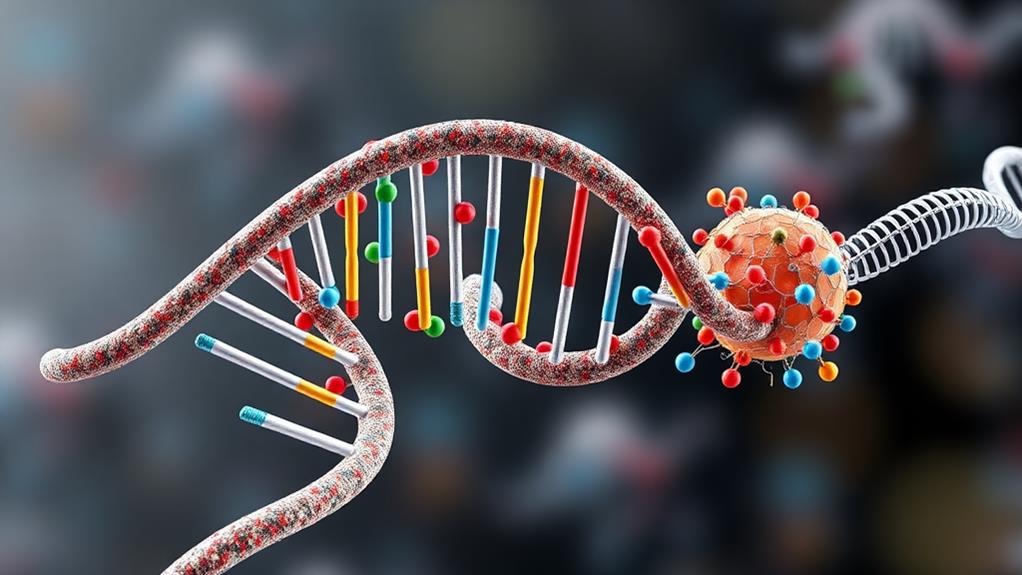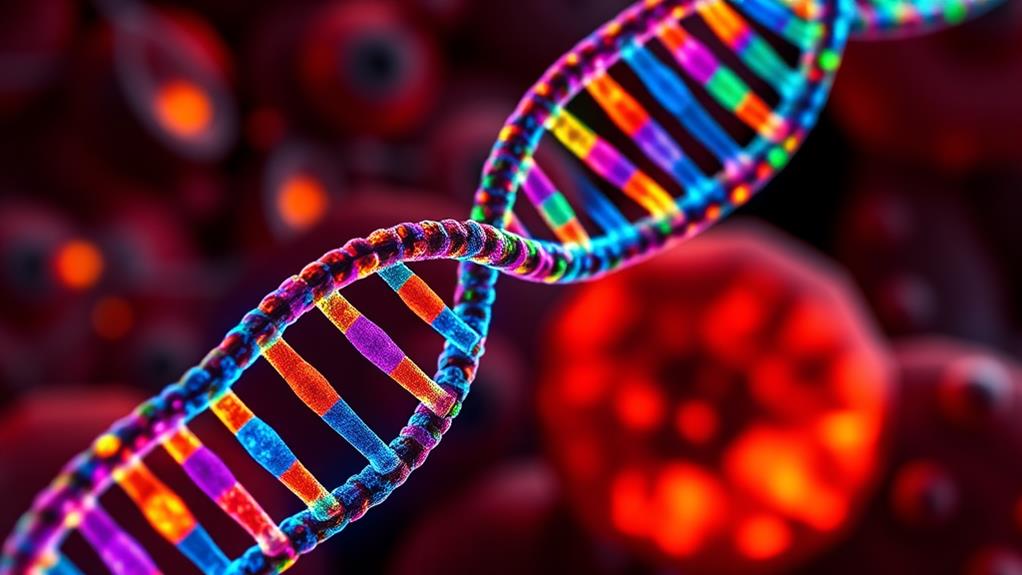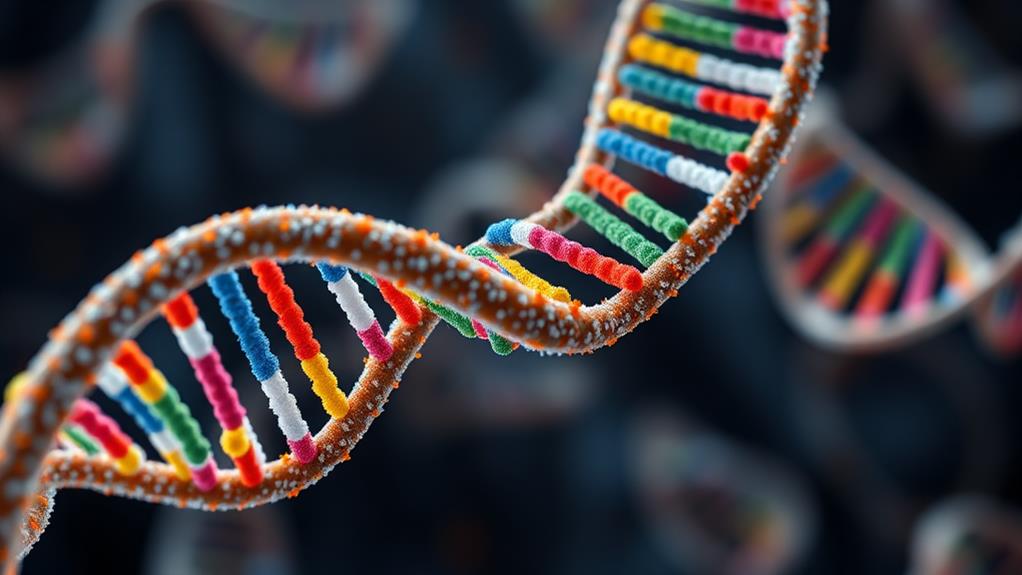DNA's structure is essential to protein synthesis. Its double helix configuration and base pairing rules guarantee accurate genetic information storage. During transcription, DNA unwinds, allowing RNA polymerase to access specific genes. Regulatory sequences like promoters and enhancers control gene expression, while chromatin structure influences DNA accessibility. The genetic code in DNA determines the amino acid sequence of proteins. Mutations in DNA can alter this sequence, potentially affecting protein function. DNA packaging and nuclear localization also play roles in gene regulation. Understanding these structural aspects of DNA is vital for grasping how your body produces the proteins necessary for life.
DNA's Double Helix Configuration
While you might think of DNA as a simple string of genetic code, it's actually a complex double helix structure that's vital for life. This unique configuration plays a significant role in protein synthesis and gene expression.
The DNA double helix consists of two strands that run in opposite directions, with a sugar-phosphate backbone providing structural support. Inside the helix, nitrogenous bases pair up: adenine (A) with thymine (T) and guanine (G) with cytosine (C).
This base pairing is key to storing genetic information and enabling accurate transcription. During transcription, the DNA unwinds, allowing one strand to serve as a template for creating messenger RNA (mRNA). The mRNA's sequence of codons, derived from the DNA's base pairs, determines the order of amino acids in proteins during synthesis.
The helical structure also allows DNA to condense into chromosomes, efficiently packaging genetic material within the nucleus. This organization facilitates proper gene expression and guarantees that the correct proteins are produced.
Fundamentally, the DNA's double helix configuration is the foundation for translating genetic code into functional proteins, driving the processes that keep you alive.
Base Pairing and Complementarity
At the heart of DNA's structure lies the principle of base pairing and complementarity. You'll find that in DNA, adenine (A) pairs with thymine (T), and guanine (G) pairs with cytosine (C). This specific base pairing is essential for accurate replication and transcription of genetic information.
When it's time for transcription, RNA polymerase reads the DNA sequence and assembles a complementary mRNA strand. The complementarity between DNA and RNA guarantees that the mRNA accurately reflects the DNA gene's sequence. This process is crucial for effective protein synthesis.
The genetic code is defined by codons, which are three-nucleotide sequences in mRNA. Each codon corresponds to a specific amino acid that'll be incorporated into a protein. This relationship between DNA structure, transcription, and the genetic code is fundamental to how your cells produce proteins.
It's important to note that errors in base pairing during DNA replication or transcription can lead to mutations. These changes may alter the amino acid sequence of proteins, potentially impacting their function.
Understanding base pairing and complementarity is key to grasping how DNA structure influences protein synthesis.
Gene Structure and Organization
Building on our understanding of base pairing, let's explore how genes are structured and organized within DNA. Genes are segments of DNA that contain the instructions for protein synthesis. They're located on chromosomes within the cell nucleus, with the human genome consisting of approximately 20,000 to 50,000 protein-coding genes.
DNA's structure plays a vital role in gene organization and function. It's wrapped around histone proteins to form nucleosomes, which are the building blocks of chromatin. This organization helps compact DNA and regulate gene expression. The position of a gene within the chromatin structure can affect its accessibility for transcription, influencing protein synthesis.
Each gene is composed of a specific sequence of nucleotides. These nucleotides form codons, which are three-base sequences that code for specific amino acids.
During transcription, the gene's sequence is copied into mRNA, which then serves as a template for protein synthesis. The order of nucleotides in a gene directly determines the amino acid sequence of the resulting protein, highlighting the essential connection between DNA structure and protein production.
Transcription Initiation Sites
Transcription initiation sites play an important role in the process of protein synthesis. These specific DNA sequences are where RNA polymerase binds to begin mRNA production.
In eukaryotic cells, you'll find that transcription initiation is a complex process involving multiple transcription factors. These proteins bind to the promoter region before RNA polymerase can attach to the DNA.
A common feature in many eukaryotic promoters is the TATA box. This element serves as a binding site for transcription factors and helps form the transcription initiation complex.
On the other hand, prokaryotic transcription is simpler. It relies on a sigma factor to help RNA polymerase recognize and bind to the promoter region.
The location of the transcription initiation site is significant, as it determines where transcription begins. This, in turn, affects the amount and type of protein synthesized.
Understanding these sites is important for grasping how DNA structure influences protein synthesis. By controlling where transcription starts, these sites play an essential role in regulating gene expression and ultimately shaping an organism's characteristics.
DNA Unwinding for Gene Access
Once RNA polymerase is positioned at the transcription initiation site, the next key step in protein synthesis is DNA unwinding. This process is vital for accessing specific genes and allowing transcription to occur.
You'll find that the double helix structure of DNA must be "unzipped" by enzymes called helicases, creating two single strands that serve as templates for RNA polymerase.
DNA unwinding doesn't happen randomly. It occurs at specific regions called promoters, where transcription factors bind and signal RNA polymerase to begin transcription.
Before this can happen, though, the DNA's packaging structure, known as chromatin, must be loosened. This involves epigenetic changes that modify the chromatin, making genes more accessible.
The unwinding process guarantees that the correct gene is expressed at the right time, influencing the types and amounts of proteins synthesized in the cell.
It's a carefully orchestrated event that's essential for proper protein synthesis. By opening up the DNA structure, you're allowing RNA polymerase to read the genetic information and create messenger RNA (mRNA), which will later be used to build proteins.
Regulatory Sequences in DNA
You'll find that regulatory sequences in DNA play a vital role in controlling gene expression.
These sequences include promoters and enhancers, which work together to initiate and boost transcription, as well as silencers that can inhibit gene activity.
Understanding these regulatory elements is essential for grasping how your cells fine-tune protein production and respond to various environmental cues.
Promoter and Enhancer Regions
In the world of DNA, promoter and enhancer regions play fundamental roles as regulatory sequences. These DNA sequences are important for controlling gene expression and, ultimately, protein synthesis.
Promoter regions are located near genes and serve as binding sites for RNA polymerase and transcription factors, initiating the transcription process. On the other hand, enhancer regions can be found far from the genes they regulate but still influence transcription levels by facilitating the binding of transcription factors.
The interaction between promoters and enhancers is essential for precise control of gene expression, allowing cells to respond to various signals and environmental conditions. Variations in these regulatory DNA sequences can lead to differences in gene expression, impacting cellular functions and contributing to developmental processes and diseases.
Additionally, epigenetic modifications, such as methylation and acetylation, can influence the activity of promoter and enhancer regions, further affecting transcriptional output. Understanding these regulatory sequences is important for comprehending how DNA structure influences protein synthesis and overall cellular function, providing insights into the complex mechanisms that govern life at the molecular level.
Silencers and Insulators
While promoters and enhancers play essential roles in activating gene expression, there's another side to the regulatory coin: silencers and insulators. These DNA elements work to fine-tune gene regulation in eukaryotic cells, guaranteeing that genes are expressed at the right time and in the right amount.
Silencers are regulatory sequences that inhibit transcription by binding transcription factors, effectively reducing gene expression. On the other hand, insulators act as barriers, blocking the interaction between enhancers and promoters to maintain the specificity of gene regulation. Together, these elements help shape the overall DNA structure and chromatin conformation, influencing how accessible genes are to transcription machinery.
The presence of silencers and insulators is critical for proper cellular function. They help guarantee that genes are expressed only in appropriate cell types and at the correct times.
However, mutations in these regulatory sequences can lead to misregulation of gene expression, potentially contributing to diseases like cancer. Understanding the roles of silencers and insulators is fundamental for comprehending how DNA structure influences protein synthesis and overall cellular function.
Chromatin Structure and Gene Expression
Let's explore the fascinating world of chromatin structure and gene expression.
Chromatin structure, consisting of DNA wrapped around histone proteins, plays a significant role in regulating gene expression. It's a key component of DNA structure that affects how genes are accessed and transcribed. You'll find that chromatin can be more or less compact, influencing whether genes are active or silent.
When chromatin is less condensed, it's easier for transcription factors and RNA polymerase to access the DNA. This open structure is typically associated with active genes, allowing for efficient transcription and protein synthesis.
On the other hand, tightly packed chromatin can suppress gene expression by making DNA less accessible.
Epigenetic modifications, such as adding or removing chemical groups to histones, can alter chromatin structure. These changes act as regulatory mechanisms, influencing gene expression without changing the DNA sequence itself.
The spatial organization of chromatin within the nucleus also impacts how genes respond to cellular signals. Understanding these complex interactions helps explain how cells control their functions and maintain their identity through precise regulation of gene expression.
DNA Packaging and Nuclear Localization
The marvel of DNA packaging is a demonstration of nature's efficiency. Within the nucleus, DNA is tightly wrapped around histone proteins, forming structures called nucleosomes. These nucleosomes are further condensed into chromatin, allowing the genetic material to fit inside the cell's command center. This compact organization isn't just about space-saving; it's essential for regulating gene expression and, ultimately, protein synthesis.
You'll find that chromosomes aren't randomly scattered in the nucleus. Each occupies a specific territory, influencing which genes are active and accessible for transcription. Actively transcribed genes are often found near the center of the nucleus, while inactive ones are pushed to the periphery. This nuclear localization plays a significant role in determining which proteins are produced.
During cell division, chromatin condenses even further into distinct chromatids, ensuring proper distribution of genetic material to daughter cells.
It's vital to recognize that epigenetic modifications can alter chromatin structure without changing the DNA sequence itself. These changes affect how genes are expressed, impacting protein synthesis and cellular function.
Understanding DNA packaging and nuclear organization is key to grasping the complexities of gene regulation and protein production.
Mutations and Protein Synthesis Impact
Mutations crop up in DNA sequences, potentially throwing a wrench into the protein synthesis machinery. These changes in the DNA sequence can alter the corresponding mRNA codons during transcription, which may lead to modifications in the amino acid sequence of proteins during translation.
You'll find that a single nucleotide mutation, like a substitution, can change an mRNA codon, resulting in the incorporation of a different amino acid. This alteration can greatly impact protein structure and function.
It's important to note that not all mutations lead to functional changes in proteins. Some mutations are silent, meaning they don't change the amino acid sequence due to the redundancy in the genetic code.
However, certain mutations can have severe consequences. For instance, a mutation in the CFTR gene causes cystic fibrosis by altering the protein responsible for ion transport across cell membranes.
You should be aware that errors during DNA replication can introduce mutations that may persist and affect protein synthesis.
These mutations can potentially lead to various genetic disorders or contribute to evolutionary change, highlighting the vital role DNA structure plays in protein synthesis.
Conclusion
You've seen how DNA's structure is essential for protein synthesis. From its double helix to base pairing, gene organization, and regulatory sequences, DNA's architecture orchestrates the entire process. It's like a biological floppy disk, storing and transmitting genetic information. Remember, DNA unwinding, chromatin structure, and nuclear localization all play their part. Mutations in DNA can greatly impact protein synthesis, highlighting the importance of maintaining DNA integrity. Understanding these mechanisms is key to grasping the foundations of molecular biology.


